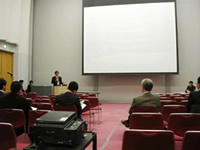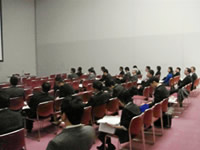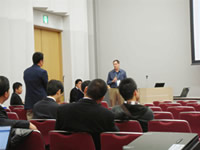


The international symposium "New Frontiers of Inorganic Nanosheets" was held at the Osaka International Convention Center (Grand Cube Osaka) on November 17, 2010, as part of the research theme of the "Creation of New Nanostructured Materials and Manufacturing Processes for Next-Generation Electronics Using Inorganic Nanosheets" (represented by Takayoshi Sasaki, Principal Investigator, National Institute for Materials Science) which is being implemented under the CREST research area of the "Establishment of Innovative Manufacturing Technology Based on Nanoscience".
Inorganic nanosheets, a new type of two-dimensional nanomaterial obtained via the delamination of layered compounds, and, being either oxidized graphene or even newer, groundbreaking materials, are a field of research that is rapidly accelerating from many standpoints including the development of new materials, pioneering new functionality, and the development of applications. This was the first symposium ever held in relation to inorganic nanosheets, bringing together, under the keyword "nanosheets", both Japanese and foreign researchers active in the field as well as specialists from the government, academia, and industry with experience in nanomaterial research. It was held as planned for the purpose of providing a venue for discussions that would serve as a foundation for future research on nanosheets. Six researchers from overseas, including Dr. Patrick Davidson (CNRS), Professor Michael Lerner (Oregon State University), Dr. Seong-Ju Hwang (Ewha Women's University), and Dr. Lianzhou Wang (The University of Queensland), and six from Japan, including Professor Masaru Miyayama (University of Tokyo), Dr. Teruyuki Nakato (Tokyo University of Agriculture and Technology), and Hideyuki Nakano (Toyota Central R&D Labs) attended, making a total of twelve invited speakers active on the very front line of the field. Along with lectures on leading edge research results from the twelve invited speakers, six members of the actual CREST team introduced topics for discussion, with a total of 94 people having participated in the symposium.
Deep discussions were held both before and after intensive sessions over the course of the day, concerning the state of leading edge research on a wide range of topics centered on nanosheets, beginning with a foundational session related to synthesis of new materials in inorganic nanosheets and structures, and including graphene, technology related to clay nanosheets, and unique photo-electronic properties of inorganic nanosheets. Also covered were topics such as solar batteries, lithium rechargeable batteries, supercapacitors, thin films with prominent polarizablility, transparent magnetic films, and applications for seed layers used for functional epitaxial growth. During the morning session there were eight presentations that covered the synthesis of new materials in inorganic nanosheets and structure, along with graphene technology related to inorganic nanosheets, and clay nanosheets. Teruyuki Nakano (Toyota Central R&D Labs) reported on the current state of research related to new silicon-based inorganic nanosheets and their unique photo-electronic properties. Professor Michael Lerner (Oregon State University) gave a presentation on technologies related to inorganic nanosheets; specifically, leading edge research results related to such topics as special characteristics of graphene bases, dispersion techniques, and carbon intercalation compounds. Dr. Lianzhou Wang (The University of Queensland) introduced the latest research results and new discoveries concerning doping techniques for titanium oxide nanosheets and photoelectric properties of element-substituted nanosheets, related to new experiments toward pioneering new functions of oxide nanosheets and visible light responsivity. Subsequently, in the afternoon session, five presentations concerning the optical characteristics of inorganic nanosheets were followed by five presentations on the electromagnetic functions of inorganic nanosheets, making a total of ten lectures. Dr. Patrick Davidson (CNRS), a pioneer in the areas of basic research on liquid crystal research and optical properties of inorganic nanosheets, reviewed the history and foundation of liquid crystal research, and then reported on the latest results of research on special characteristics of liquid crystals making use of unique electric and magnetic field responses. Dr. Teruyuki Nakato (Tokyo University of Agriculture and Technology) and Dr. Nobuyoshi Miyamoto (Fukuoka Institute of Technology) presented the latest research results on oxide nanosheet liquid crystallinity and its applications. Dr. Shintaro Ida (Kyushu University) introduced the latest research results related to synthesis of rare earth additive nanosheets and luminescent properties. In addition, concerning electromagnetic functions and their applied technologies, Dr. Seong-Ju Hwang (Ewha Women's University) introduced the latest research results and new discoveries related to photo-electrochemical and electrochemical properties of new transition metal nanosheets and their hybrid materials. Professor Masaru Miyayama (University of Tokyo) spoke about nanosheet based lithium rechargeable batteries and the state of leading edge development of that technology. All the presentations were of extremely high quality, and the actual CREST group was able to acquire a great deal of encouragement as well as knowledge that can be used as useful information in their activities.
The CREST team itself made six presentations, the research results of which were met with great appeal and thoroughly discussed by many of the symposium's participants. Those presentations consisted of a review of inorganic nanosheets (Takayoshi Sasaki), new hydroxide nanosheets and their applications (Renzhi Ma), luminescent nanosheets and their applications as fluorescent materials (Tadashi Ozawa), applications for ruthenium oxide nanosheet supercapacitors (Wataru Sugimoto), applications for seed layers for functional epitaxial growth of thin films (Tatsuo Shibata), and new electromagnetic properties (Minoru Osada).
Finally, the meeting was successfully concluded as we heard from many of the participants that they thought this symposium with its focus on inorganic nanosheets was highly valuable and significant, and that they look forward with great anticipation to repeating the event in the future. This symposium provided an opportunity to further develop interactions with the foreign research community, and we intend to proactively move forward with research and development in order to be able to seize the initiative in nanosheet research.
JST, an integrated organization of science and technology in Japan, establishes an infrastructure for the entire process from the creation of knowledge to the return to the society. For more information, visit http://www.jst.go.jp/EN/